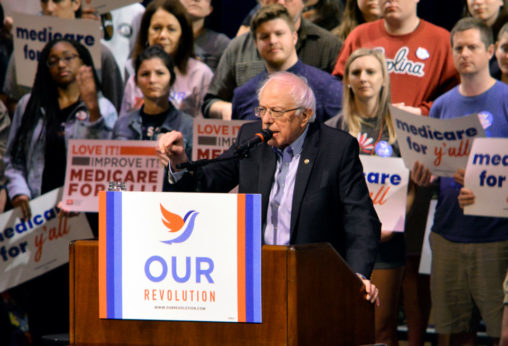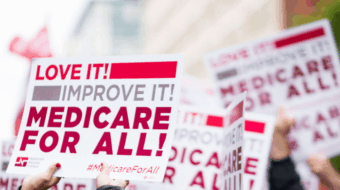
You can tell that Medicare for All is becoming a real possibility when it gets a rigorous cost-benefit analysis and when its advocates start seriously raising and addressing the inevitable downsides of the policy. There is no greater downside to Medicare for All than the 1.8 million clerical and administrative jobs it will eliminate in the insurance industry and in health providers’ offices.
In their nearly 200-page Economic Analysis of Medicare for All, researchers at the Political Economy Research Institute (PERI) at the University of Massachusetts provide a thorough cost-benefit analysis of Sen. Bernie Sanders’ proposal (Senate Bill 1804). And for the first time, they’ve estimated the likely magnitude and character of jobs that will be lost and have taken a first crack at suggesting what to do about that job loss. I want to critique their “just transition” program for these workers, but before I get to that, let me first marvel at the level of detail in their analysis.
It’s an important moment. Medicare for All is no longer just a fine sentiment, but a real policy with all the nuts and bolts and messiness of things that are real. The PERI analysis is rightly focused on how much the new system will cost and how to pay for it. They figure it will cost the government about $1 trillion a year above current costs, with nearly 60 percent of that being paid by employer contributions that will be lower than they are currently paying. The rest is paid for with a sales tax on non-necessities, a small wealth tax, and taxing capital gains as ordinary income.
In the long-run, though more expensive for the government, Medicare for All will reduce the country’s overall health expenditures by about $500 billion a year. Most of the savings will go to workers and households in lower premiums and out-of-pocket costs. Plus, of course, everybody will be assured of access to the health care they need—a huge direct benefit to the more than one-third of us who are uninsured or underinsured while providing everyday peace of mind and life-planning stability, as well as more take-home pay, for all of us.
As the study is at pains to point out, however, the transition from the current system, which is both wasteful and of mediocre quality, to Medicare for All will be tricky. The bulk of the savings comes from the dramatic reduction in paperwork and administration that will result from eliminating private health insurance. But this also means a huge job loss over a 2- to 4-year period—about 800,000 jobs in the insurance industry and a little more than 1 million in doctors’ offices, clinics, hospitals, and other health providers.
The PERI analysis profiles these workforces by occupations, average wages, ages, educational credentials, and racial and gender composition. That analysis shows the median wage in health insurance is $54,400 but only about $39,400 in health care administration, where 92 percent of workers are women compared with only 55 percent in insurance. The level of statistical detail PERI produces on these workers is itself refreshing and is fairly rare in not treating dislocated workers as after-thoughts at best and chaff at worst—as so many industrial and extractive workers have been treated in public policy in the past.
It is also refreshing that the PERI authors insist on a “just transition” and open up that discussion. Their program would use ERISA, the federal government regulatory agency for private pensions, to ensure that health insurance companies and providers cannot raid their currently solvent pension funds, thereby guaranteeing all workers their current pension benefits. In addition, of the 1.8 million displaced workers, nearly 300,000 are 60 years or older and that part of the workforce is treated very generously—they will be paid 100 percent of their current salaries until age 65 if they choose to retire.
But the rest of the plan, though probably the most generous ever proposed for dislocated workers, is just not enough, and it leaves Medicare for All subject to political backlash that could be offset by a more thorough program. It leaves about 1.5 million displaced workers, who would be guaranteed one-year’s salary and would receive $10,000 each to pay for education or training and $10,000 each to cover relocation expenses. This is historically generous, but it is not enough, primarily because the American system of training is an ill-coordinated mess about which workers are highly, and rightly, cynical.
In the Rust Belt, for example, so-called Trade Adjustment Assistance training programs have been notoriously poorly funded and have often led not to jobs but to flooded labor markets for specific occupations, thereby pulling down wages in those occupations. Likewise, the relocation assistance is very generous money-wise, but the U.S. does not have a nationally coordinated employment system that helps workers find out where they might be needed elsewhere in the country. So, though very generous, the PERI proposal pretty much throws money at displaced workers and tells them to figure out what to do on their own.
Without a nationally coordinated training and employment system, I fear this “just transition” will be rightly seen as merely “buying off while selling out” these workers. What’s more, helping workers relocate does nothing for the communities those workers are leaving—an issue especially important in places where insurance or health care is concentrated, like Connecticut for insurance and Pittsburgh for health care.
What is needed is a jobs program for these (and other) workers—that is, a systematic effort to create and stimulate job creation. Here’s where Medicare for All could meet with a now widely discussed Green New Deal, which would create more than a million jobs. However, these jobs, primarily in construction and manufacturing, are likely to disproportionately benefit men, while the dislocated workers in health and insurance administration are 75 percent women.

For administrative workers displaced by Medicare for All, we need a plan that matches existing skills with the training needed for jobs that can be productively created. Maybe House Democrats could commission an audit of the number and kind of government jobs that are needed to greatly improve our government’s functioning at all levels—beginning perhaps with the jobs that would support a competent national system of training and employment.
Or maybe create more positions like those 50,000 Internal Revenue Service auditors who would produce six times their own salaries by tracking down some of the $400 billion in tax fraud and avoidance that occurs each year. Likewise, most federal and state government agencies are understaffed to adequately perform their jobs, often purposely so because of decades of Republican budget cuts. And rare is the teachers’ strike today that doesn’t document the crying need for more librarians, social workers, and nurses, as well as for smaller class sizes that would require more teachers. A 10 percent increase in government workers at all levels, phased in over a four-year period, would produce more than two million jobs.
I have no idea whether an increase of that magnitude would be realistic or desirable, but that’s what an audit of employment needs would provide. What I am sure of, however, is that even the generous amounts of money provided in the PERI proposal are political liabilities—not only among workers directly affected and their friends and neighbors, but also for all those who are sick to death of hearing about “retraining and relocation” that is almost always nothing but a tragically ineffective sop, something politicians say to make us think they care. We need plans that provide training for specific jobs that we know are being created, with at least some jobs that can be located in places that need them most.
The Sanders bill and the PERI analysis, pushed by nurses’ and other unions who have built a social movement for health care as a right, are making Medicare for All a real possibility. But there is still time for them to design a much more just transition for the workers who will be dislocated so that all of us can enjoy better, cheaper, and more secure health care.
Editor’s Note: An excellent summary of the PERI analysis is available in a video interview with chief author Robert Pollin at Common Dreams.
This article originally appeared at the Working-Class Perspectives site, hosted by Georgetown University’s Kalmanovitz Initiative for Labor and the Working Poor.










